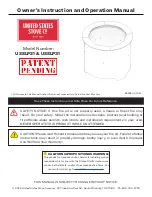
1 8
Chapter 11
I N S T A L L A T I O N M A N U A L |
11
OPERATING THE FIREPLACE
11�1
BEFORE THE FIRST FIRE
1.
Make sure the cables of the ignition are hanging loosely under the
device, to ensure a good ignition. Remove any tie wraps or other
cable binders.
2.
Make certain that all construction materials have been removed
from inside and around the fireplace and the fireplace has been
cleaned of any construction dust.
3.
Clean the glass BEFORE and AFTER the first fire on both sides of
the glass.
4.
Properly place, clamp and seal the glass panels.
5.
Ensure the receiver is powered with an AC Adapter OR Batteries,
but not both!
6.
Place the two (2) AAA batteries into the remote control and
confirm that it will communicate with the receiver by pressing the
ON/OFF button.
7.
Check the pilot and second thermocouple for obstructions
8.
Check the air tightness of the system.
More technical specifications can be found in
APPENDIX F
APPENDIX F
.
11�2
THE FIRST FIRE
When the fireplace is fired for the first time, one should check the
behaviour of the fireplace to see if all is functioning well.
Should any problems occur during first firing a troubleshooter can be
found in
APPENDIX A
APPENDIX A
for the gas parts and
APPENDIX B
APPENDIX B
provides an
overview of possible error codes in the remote control.
11�3
SENSORY CHECKS
11�3�1
VISUAL CHECKS
Condensation
When the glass is cold, some condensation may appear on the glass after
lighting the fireplace. This is normal as the combustion air contains a little
water and the product of the gas being burned is not yet evaporating.
The condensation will disappear as the glass warms.
To ensure as little condensation as possible and, as an additional
benefit, to decrease the release of solid nitrogen oxide particles which
are bad for the environment, the fireplace will start on just the main
burner. During the first minute of firing this will ensure your fireplace
to evaporate the condensation on the glass and heat up the air in the
combustion chamber.
Please note:
During the first minute of firing i.e. the initial start up
sequence of lighting the pilot flame and the first 30 seconds until the
second thermocouple has given its clear, it is not possible to use the
'double plus'-button to switch between burners.
Flames and soot
During this first fire, examine the flame for appearance and quality.
Flames may appear blue at first, but will turn yellow after 15 to 20
minutes.
Examine the logs for sooting. Too yellow (near orange) flames indicate a
problem with the combustion air. Clear black soot may then settle on the
decoration material. When this is the case, you may contact your dealer.
This fireplace has a 2nd thermocouple saftey system, which senses the
burner flame. The system will turn itself off if the system does not sense
the 2nd thermocouple output within 29 seconds after the valve opens.
Coating
When firing up the device for the first time, make sure the device burns
for several hours on the highest level, to ensure the lacker to harden. If
an enclosure has not yet been constructed, these fumes may also be
visible around the fireplace.
Because a fireplace is a heat source, natural convection will occur around
it. Solid particles in the circulating air may burn and settle down on cold
surfaces, causing discoloration. Discoloration is an annoying problem
and it is difficult to solve once happened.
These particles can come from construction moisture or cigarette smoke,
but also they might be volatile components in paint, construction
materials or carpeting. For newly constructed chimneys or after a big
reconstruction, it is advised to wait a minimum of six weeks before firing
a fireplace. After this burn-off period, turn off the fireplace and let it cool
completely to room temperature and once again clean both sides of the
glass as well as the interior panels.
11�3�2
SMELL CHECK
When the fireplace is first heated, an odor may be given off by the hot
metal. Make sure the device and enclosure are ventilated enough, so the
possible released fumes are being abducted. The fumes are the result of
the ‘burn off’ of the lubricants and sealants used when manufacturing
the fireplace.
We advice to be as little in the room as possible during this process. It is
recommended that you open the nearby windows for extra ventilation
and then operate the fireplace for at least four hours.
11�3�3
SOUND CHECK
Since the product is a metal fireplace, the heat-up and cool-down
cycles may produce some (initial) noises caused by the expansion and
contraction of these metals. These are normal but should not be audible
at more than a meter distance from the fireplace.
















































